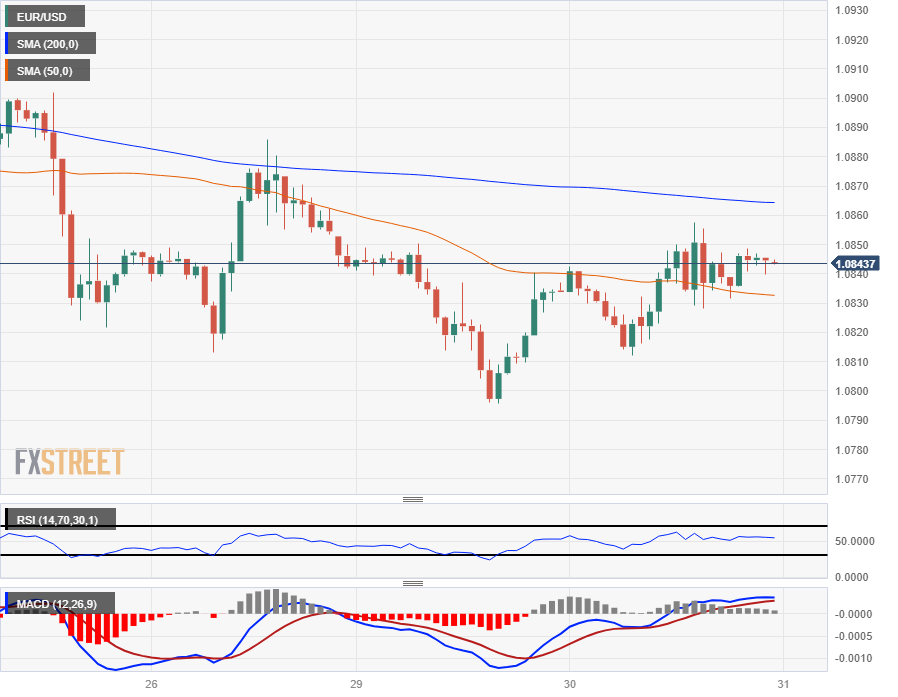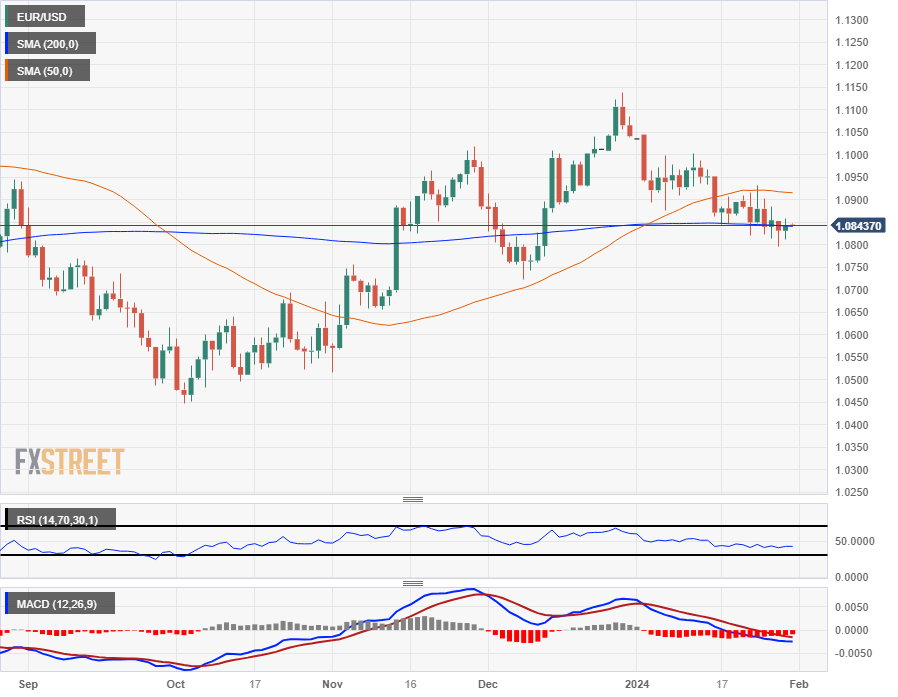EUR/USD sticks close to 1.0850 after euro area GDP beats
- EUR/USD extends rebound from 1.0800 on flat QoQ GDP print.
- Euro area bounce remains limited after German GDP constricts.
- German Retail Sales, CPI inflation due Wednesday ahead of Fed rate call.
EUR/USD climbed further on Tuesday after staging a near-term comeback from 1.0800 this week, extending a recovery after Euro area Gross Domestic Product (GDP) figures stayed flat instead of declining as markets forecast.
Europe next sees German Retail Sales and Consumer Price Index (CPI) inflation on Wednesday before the US Federal Reserve (Fed) drops their latest Monetary Policy Statement.
Daily digest market movers: EUR/USD climbs on GDP beat, but upside limited by Greenback bids
- EUR/USD is still up 0.4% from the week’s low of 1.0796 but remains capped by 1.0850.
- European GDP stayed flat at 0.0% for the fourth quarter compared to the forecasted -0.1% decline.
- YoY quarterly GDP also beat the street, printing at 0.1% versus the forecast flat print of 0.0%.
- Clouds still persist in Euro area outlook after German QoQ GDP declines -0.3%, in-line with forecasts.
- German YoY Retail Sales due on Wednesday, last came in at -2.4%.
- German CPI inflation for the year ending in January expected to decline to 3.2% from the previous period’s 3.8%.
- US ADP Employment Change due Wednesday before Fed rate call, ADJ jobs expected to shift lower to 145K in January versus the previous 164K.
- Fed is broadly expected to hold rates steady once more on Wednesday, but markets will be looking for a dovish pivot from Fed Chairman Jerome Powell to reignite rate cut hopes.
- Market sees less than 40% chance of a rate cut in March, May sees just 15% chance of rates staying where they are.
Euro price today
The table below shows the percentage change of Euro (EUR) against listed major currencies today. Euro was the strongest against the Australian Dollar.
| USD | EUR | GBP | CAD | AUD | JPY | NZD | CHF | |
| USD | -0.13% | 0.12% | -0.11% | 0.16% | 0.08% | -0.01% | 0.05% | |
| EUR | 0.11% | 0.22% | 0.00% | 0.27% | 0.20% | 0.11% | 0.15% | |
| GBP | -0.12% | -0.24% | -0.23% | 0.04% | -0.04% | -0.13% | -0.07% | |
| CAD | 0.11% | 0.01% | 0.23% | 0.27% | 0.20% | 0.11% | 0.17% | |
| AUD | -0.17% | -0.29% | -0.05% | -0.27% | -0.08% | -0.17% | -0.11% | |
| JPY | -0.09% | -0.20% | 0.06% | -0.19% | 0.05% | -0.09% | -0.03% | |
| NZD | 0.00% | -0.12% | 0.12% | -0.11% | 0.16% | 0.07% | 0.04% | |
| CHF | -0.06% | -0.16% | 0.07% | -0.16% | 0.12% | 0.03% | -0.05% |
The heat map shows percentage changes of major currencies against each other. The base currency is picked from the left column, while the quote currency is picked from the top row. For example, if you pick the Euro from the left column and move along the horizontal line to the Japanese Yen, the percentage change displayed in the box will represent EUR (base)/JPY (quote).
Technical Analysis: EUR/USD stuck on the low side of 1.0850
Despite a rebound from near-term lows, EUR/USD remains constrained below the 200-hour Simple Moving Average (SMA) moving down into 1.0860. The pair is set to remain bearish as lower highs drag median prices further down the charts.
EUR/USD continues to drift into a technical congestion pattern on the daily candles, with price action hampered by the 200-day SMA near 1.0850 and the 50-day SMA preparing to roll over into a bearish crossover from 1.0900.
EUR/USD hourly chart
EUR/USD daily chart
Euro FAQs
What is the Euro?
The Euro is the currency for the 20 European Union countries that belong to the Eurozone. It is the second most heavily traded currency in the world behind the US Dollar. In 2022, it accounted for 31% of all foreign exchange transactions, with an average daily turnover of over $2.2 trillion a day.
EUR/USD is the most heavily traded currency pair in the world, accounting for an estimated 30% off all transactions, followed by EUR/JPY (4%), EUR/GBP (3%) and EUR/AUD (2%).
What is the ECB and how does it impact the Euro?
The European Central Bank (ECB) in Frankfurt, Germany, is the reserve bank for the Eurozone. The ECB sets interest rates and manages monetary policy.
The ECB’s primary mandate is to maintain price stability, which means either controlling inflation or stimulating growth. Its primary tool is the raising or lowering of interest rates. Relatively high interest rates – or the expectation of higher rates – will usually benefit the Euro and vice versa.
The ECB Governing Council makes monetary policy decisions at meetings held eight times a year. Decisions are made by heads of the Eurozone national banks and six permanent members, including the President of the ECB, Christine Lagarde.
How does inflation data impact the value of the Euro?
Eurozone inflation data, measured by the Harmonized Index of Consumer Prices (HICP), is an important econometric for the Euro. If inflation rises more than expected, especially if above the ECB’s 2% target, it obliges the ECB to raise interest rates to bring it back under control.
Relatively high interest rates compared to its counterparts will usually benefit the Euro, as it makes the region more attractive as a place for global investors to park their money.
How does economic data influence the value of the Euro?
Data releases gauge the health of the economy and can impact on the Euro. Indicators such as GDP, Manufacturing and Services PMIs, employment, and consumer sentiment surveys can all influence the direction of the single currency.
A strong economy is good for the Euro. Not only does it attract more foreign investment but it may encourage the ECB to put up interest rates, which will directly strengthen the Euro. Otherwise, if economic data is weak, the Euro is likely to fall.
Economic data for the four largest economies in the euro area (Germany, France, Italy and Spain) are especially significant, as they account for 75% of the Eurozone’s economy.
How does the Trade Balance impact the Euro?
Another significant data release for the Euro is the Trade Balance. This indicator measures the difference between what a country earns from its exports and what it spends on imports over a given period.
If a country produces highly sought after exports then its currency will gain in value purely from the extra demand created from foreign buyers seeking to purchase these goods. Therefore, a positive net Trade Balance strengthens a currency and vice versa for a negative balance.